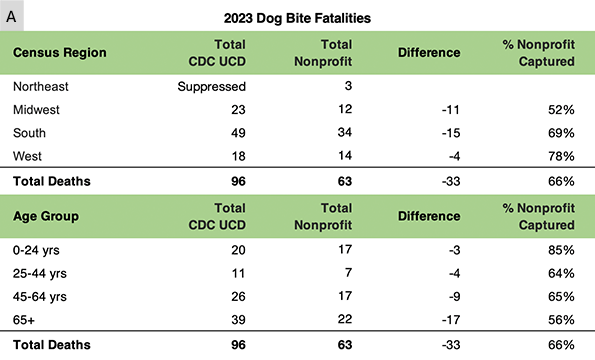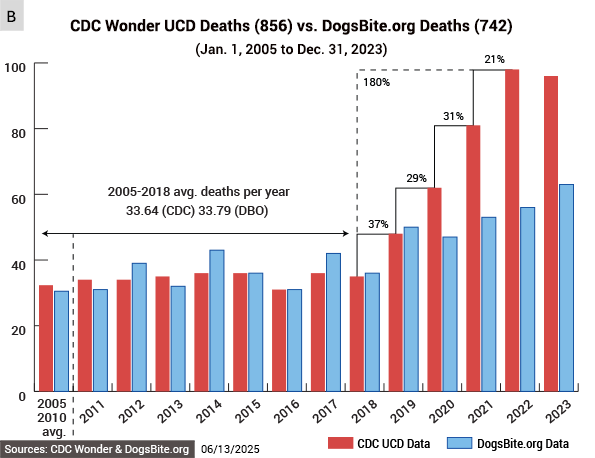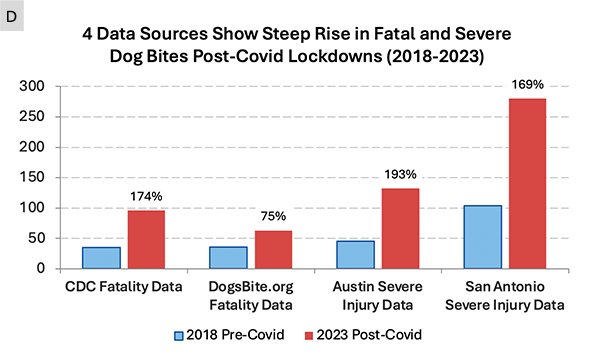Dog Bite Fatalities Leveled Off in 2023; Nonprofit Capture Rate Rose

DogsBite.org - In October, we published the 2022 Macro-Level Forces Report for U.S. dog bite fatality data. Current data shows that during 2022, the third Covid year, our nonprofit had a 42-victim deficit compared to CDC Wonder underlying cause of death (UCD) data, a 55% difference in the number of deaths. The victim deficit during the fourth Covid year, 2023, is an improvement. CDC Wonder data shows there were 96 dog bite fatalities in 2023. Our nonprofit recorded 63 deaths, a 42% difference.
96 fatal dog attacks in a single year is down slightly from the record high of 98. This is still a 100% increase from 2019 and a 174% increase from 2018.
Prior to the pandemic (2005 to 2019), the largest deficit of unreported deaths our nonprofit had compared to CDC data was 4 each for the years 2005 and 2010. During 2023, there was a deficit of 33 unreported deaths. Without our FOIAs, the deficit would have been 38. The disparity during 2023 signals the first reversal of the deficit trend since the onset of Covid. The average number of citations captured per victim in 2023 fell 31% (15.7) from the pre-Covid baseline year of 2019 (22.7).
A regional breakdown of dog bite fatalities in 2023 shows the Midwest and South had the most unreported deaths. According to CDC Wonder data, 68% (65 of 96) of the victims in 2023 were ≥ 45 years old. Our nonprofit captured 60% (39 of 65), up from 47% in 2022 and 51% in 2021. Historically, the ≥ 50 age group has been underrepresented in media reports. We discussed this disparity in our 2020 discussion notes (Comparing 15-Year Data Sets - DogsBite.org Data and CDC Wonder Data).
Related report:
2023 Macro-Level Forces Report: CDC Dog Bite Fatality Data Compared to Nonprofit

Chart A: U.S. dog bite fatalities during the fourth Covid year, 2023, by Census region and age.
Characteristics of Unreported Fatal Dog Attacks (2005 to 2024)
Since 2011, we have uncovered 39 unreported deaths by FOIAs or other means. Most of them, 64% (25), occurred after March 2020. The most likely unreported fatal dog attack is an adult ≥ 40 years old, 74% (29), killed by a single or pair of pit bulls, 66% (19 of 29), in an urban area, 83% (24 of 29), within a state that prohibits or limits breed restriction laws. Of the 39 total deaths, 72% (28) involved pit bulls, and of that, 64% (18 of 28) involved a single or pair of family pit bulls killing a household member.
72% (28) of the total unreported fatal attacks involved family dogs killing a household member, and 64% (25) involved a single dog attacking.
During 2023, the 5 unreported deaths we uncovered included three adults, ≥ 40 years old and two young children. Two deaths were not discovered until this year. Estela Manteca was identified after a federal lawsuit was filed in Texas. Amya Jeffery was identified after Ohio news organizations released a 4-part investigation into the state's weak dangerous dog laws. Of the 9 total unreported child deaths since 2011, 89% (8 of 9) were killed by a bull breed: pit bull (4), American bulldog (3) and mastiff (1).

Chart B: CDC dog bite fatality data compared to DogsBite.org data over 19 years (2005-2023).
Discussion
Initially, Chart B appears to reflect the pandemic kicked off a visible increase in year-to-year deaths. However, the largest increase is from 2018 to 2019, a 37% rise, which occurred pre-Covid. From 2019 to 2020, there was a 29% rise in deaths, from 2020 to 2021, a 31% rise, from 2021 to 2022, a 21% rise, and in 2023, deaths leveled out. Between 2018 to 2023, there was a 174% rise in dog bite fatalities. After Covid-19 macro-forces erupted in 2020, our capture rate declined each year after until 2023.
Currently, provisional data from CDC shows that dog bite fatalities rise to 113 deaths in 2024. Apparently, the leveling off is 2023 is an anomaly.
The chart also shows that between 2005 and 2018, the average number of deaths per year captured by our nonprofit was 33.79, compared to CDC Wonder data of 33.64. The annual number of deaths during that 14-year period gradually increases but otherwise shows slight variation. After four years of Covid conditions, between January 1, 2020, and December 31, 2023, the average number of deaths per year captured by our nonprofit rose to 54.75, and CDC Wonder data shot up to 84.25.
Thus, one must ask what trends shifted between 2018 and 2023, when the number of deaths per year rose by 174% (from 35 CDC death data to 96). The number of dog bite fatalities increased during that period much faster than the 14-year period between 2005 to 2018. After years of annual deaths in the 30s range, CDC data suddenly skips deaths in the 50s and 70s ranges. CDC data shows that in 2019, there were 48 deaths; in 2020, 62 deaths; in 2021, 81 deaths, in 2022, 98 deaths, and in 2023, 96.
Pre-Covid Trends
In our nonprofit's data, several trends were seen prior to 2019. Between 2005 to 2018, the ages and genders of victims between the first and third periods (2005-2009 and 2015-2018) show that the percentage of fatal dog attacks involving adults 45-64 years old rose 56%. This was largely driven by females, 45-64 years old, which rose 96%. Male deaths declined overall, but the 45-64 year old male age group rose 20%. During this period, the percentage of fatal attacks involving pit bulls rose 29%.
While the number of "actual" rescue/shelter dogs involved in fatal dog attacks is unobtainable, our data shows the percentage of people killed by rescue dogs jumped from 2.7% during the first period (2005-2009) to 15.9% during the third period (2015-2018), a rise of nearly 500%. Owner-directed fatal dog attacks rose from 10.7% to 17.2% between the two periods, a 61% rise. Those were some trends heading into 2019, which began the steep ladder increase in CDC data from 2019 to 2023.1
Pre- and Post-Covid (2018 to 2023)
Our nonprofit's data established that some trends began prior to the first Covid year, namely the percentage of victims ≥ 45 years old were rising, as well as deadly attacks inflicted by pit bulls and rescue dogs. From 2018 to 2023, the number of fatal dog attacks we captured rose from 36 deaths to 63, a 75% increase. CDC data -- which contains no dog breed, ownership or attack information -- rose from 35 deaths to 96, a 174% increase. CDC data also shows that victims ≥ 45 years old were rising.
Our 18-month investigation into the near tripling of severe injury dog bites in Austin (193%) and San Antonio (169%) during the same period, 2018 to 2023, shows a similar rise. Both cities also showed a significant rise in victims ≥ 40 years older, 433% in Austin and 396% in San Antonio.2-3 Pit bulls were disproportionately involved in these attacks, responsible for 47% of severe injury bites in Austin and 31% in San Antonio. From 2018 and 2023, severe bites inflicted by pit bulls in Austin rose 533%.4
Fatality data we collected pre-Covid showed that attacks by rescue dogs jumped nearly 500% between two periods that ended in 2018. During the more recent period, 2019 to 2023, Austin Animal Center (AAC), which bills itself as a top "no-kill" shelter, recycled over 350 dogs with a moderate or severe bite history back into the community. The city admitted that some of the rehomed biting dogs attacked again, contributing to the 193% rise in severe bite injuries in Austin from 2018 to 2023.5
Rehomed biting and aggression prone dogs from public and private no-kill shelters are contributing to the rise of fatal and severe injury dog attacks.
All four areas of dog bite data -- CDC fatalities, our recorded fatalities and analysis of severe injury dog bites in Austin and San Antonio -- show a disproportionate rise of victims in the ≥ 45 age group. This is true when rate is measured too, per population 10 million, in CDC data. In Chart C, all four age groups in CDC data rise between the two periods (2012-2017 and 2018-2023), but combined into two groups, victims ≥ 45 years old, largely driven by females, is rising faster than victims ≤ 44 years old.

Chart C: CDC data shows rate of dog bite fatalities by age group, per population 10 million, divided into 3 year sets (2006-2023). Also shows rate of male/female ≥ 45 years old.
Covid 2023 Conditions
The CDC Museum Covid Timeline ends in July 2022. In May of 2023, the WHO declared an end to the public health emergency. But "long Covid" and post-Covid conditions persisted. Nationwide, according to the Center on Budget and Policy Priorities, "from a jobs and growth standpoint, the economy was essentially healed by the end of 2023."6 The toll of Covid by the end of 2023 was on track to reach $14 trillion dollars, according to the USC Schaeffer Institute for Public Policy & Government Service.7
Possible Covid conditions contributing to the disparity of 33 unreported dog bite fatalities in 2023 continues to be the eroding landscape of the news industry. Media companies slashed over 20,000 jobs in 2023, of which nearly 2,700 were in the news industry. This is higher than news media job losses in 2022 and 2021. There are now more "news deserts" -- counties without a local news outlet -- than ever. Up until Covid, we primarily relied upon news reports to document dog bite fatalities.
As our victim deficit shows in comparison to CDC data, relying on news reports to gage an accurate dog bite fatality count is no longer viable.
In 2023, Google had not started using the "AI Overview," which stops traffic referrals to websites, including news publishers. The overview launched in May 2024. Between 2022 and 2025, major news publishers lost up to half of their referrals from Google. Industry leaders are now bracing for when "traffic from Google will drop toward zero." Google isn't a search engine today, it's an answer engine. "Generative AI is now rewiring how the Internet is used all together," states the Wall Street Journal.
Summary
During 2023, there was a 31% (15.7) reduction in the number of citations per victim compared to the pre-Covid baseline (22.7). The deficit of unreported fatal dog attacks fell to 33 deaths. CDC data shows that dog bite fatalities leveled off in 2023, dropping to 96 deaths from 98 deaths in 2022. This is still a 100% increase from 2019 and a 174% increase from 2018. Victims ≥ 45 years old accounted for the most unreported dog bite fatalities, and most attacks occurred in the South and Midwest regions.
Provisional CDC data for fatal dog maulings in 2024 shows there were at least 113 fatal attacks. It will be months before that number is finalized.
There was a significant increase of fatal dog attacks during the 2020, 2021, 2022 and 2023 Covid years, but the growth began in 2019. The largest rise occurred between 2018 and 2019, with a 37% rise in dog bite fatalities. What drove that growth likely continued through the Covid years, combined with being impacted by Covid conditions, along with new research showing a "sustained effect" post-Covid:8 the rate of fatal and severe injury dog bites rose considerably after Covid restrictions ended.
After examining pre- and post-Covid data between 2018 to 2023, including CDC fatality data, our fatality data and analysis of severe injury dog bites in Austin and San Antonio, several trends emerged. (1) Fatal and severe injury dog bites increased in frequency, (2) there was a disproportionate rise of victims ≥ 45 years old, (3) data showed that pit bulls were the chief perpetrators of fatal and severe bites, and (4) rehomed biting dogs from shelters contributed to the rise of these serious injuries.

Chart D: Four different data sources show a steep rise in fatal and severe dog bite injuries post-Covid lockdowns (2023), compared to pre-Covid conditions (2018).
2Dog Bites by Severity and Age Groups (2012-2023) (PDF), Austin Animal Center, DogsBite.org.
3Dog Bites by Severity and Age Groups (2012-2023) (PDF), San Antonio Animal Care Services, DogsBite.org.
4Severe Bites: Top-Biting Dog Breeds & Severity (2012-2023) (PDF), Austin Animal Center, DogsBite.org.
5Proposed Changes Related to the Austin Animal Services Office, City of Austin Council Work Session, Page 10. January 30, 2024.
6Chart Book: Tracking the Recovery From the Pandemic Recession, Center on Budget and Policy Priorities, April 3, 2024 (cbpp.org).
7COVID-19’s Total Cost to the U.S. Economy Will Reach $14 Trillion by End of 2023, By Jakub Hlávka, PhD, Adam Rose, PhD, USC Schaeffer Institute for Public Policy & Government Service, May 16, 2023 (schaeffer.usc.edu).
8Dog Bites Are Increasing in Frequency and Severity - A Sustained Effect Following the COVID-19 Pandemic, by O'Hara N, J Plast Reconstr Aesthet Surg., 2024 Aug:95:21-23.
Related articles:
03/21/24: Review: Five Dog Bite Fatalities Between 2017-2022 in the U.S. Unreported by Media
01/25/24: Review: Three Dog Bite Fatalities Between 2022-2023 in the U.S. Unreported by Media
02/30/24: 2023 Fatal Dog Attack Breed Identification Photographs - DogsBite.org
Macro-level forces reports:
Macro-Level Forces Report: Covid Impacts of 2022 U.S. Dog Bite Fatality Capture Rate of Nonprofit
Macro-Level Forces Report: Covid Impacts of 2021 U.S. Dog Bite Fatality Capture Rate of Nonprofit
Macro-Level Forces Report: Covid Impacts of 2020 U.S. Dog Bite Fatality Capture Rate of Nonprofit

Thank you for all your diligent work in compiling the data on these fatalities and the reporting (or lack thereof) of such events — essential information for grasping both the increase in fatal attacks (and severe injury) and the lacunae in public awareness.